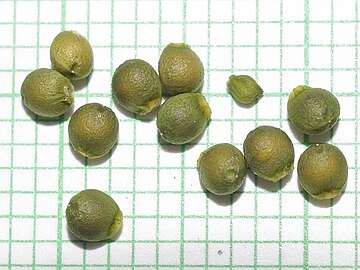
Hibiscus laevis, the halberd-leaf rosemallow, is a herbaceous perennial flower native to central and eastern North America. Their showy, creamy-white or pink flowers are large, up to 15 centimetres (6 in) across, and are hard to miss. These flowers require exposure to sunlight to open up properly, and then last only a single day.
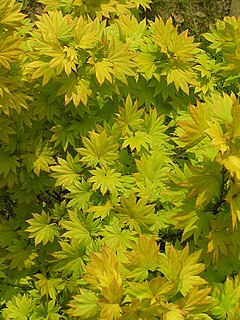
Acer shirasawanum, the Shirasawa maple or fullmoon maple, is a species of maple native to Japan, on central and southern Honshū, Shikoku, and Kyūshū.
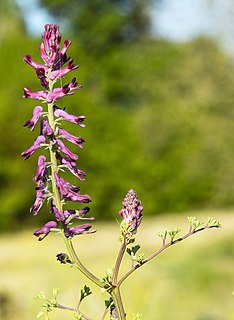
Fumaria officinalis, the common fumitory, drug fumitory or earth smoke, is a herbaceous annual flowering plant in the poppy family Papaveraceae. It is the most common species of the genus Fumaria in Western and Central Europe.

Hunnemannia is a monotypic genus of flowering plants in the poppy family Papaveraceae, containing the single species Hunnemannia fumariifolia native to the highlands of Mexico. It is typically found at elevations of 1,500–2,000 m (4,921–6,562 ft) in the Chihuahuan Desert and south into central Mexico, where it favors rocky habitats, occurring along roadsides as well.

Kleinhovia hospita is an evergreen, tropical tree native to Indonesia, Malaysia and other parts of tropical Asia. It is monotypic, being the only species in the genus Kleinhovia.

Malva alcea is a plant in the mallow family native to southwestern, central and eastern Europe and southwestern Asia, from Spain north to southern Sweden and east to Russia and Turkey.

Dicentra eximia is a flowering plant with fernlike leaves and oddly shaped flowers native to the Appalachian Mountains. It is similar to the Pacific bleeding-heart, which grows on the Pacific Coast. Dicentra eximia is a perennial herb in the Papaveraceae family.
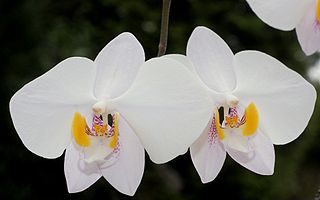
Phalaenopsis philippinensis is an endemic species of orchid found from Luzon island in the Philippines.

Dicentra peregrina is a herbaceous perennial growing from a rhizome, native to mountains in Japan and nearby areas of East Asia.
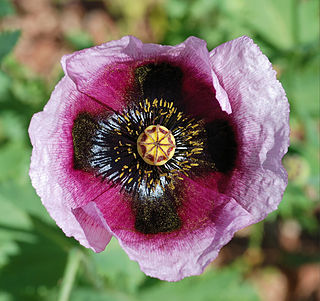
Papaver setigerum, common name poppy of Troy or dwarf breadseed poppy, is a herbaceous annual plant of the family Papaveraceae.
Corydalis micrantha is a plant which goes by many common names including smallflower fumewort, southern corydalis, and golden corydalis. It belongs to the family Papaveraceae and is native to the United States.

Fumaria capreolata, the white ramping fumitory, is an herbaceous annual plant in the poppy family Papaveraceae. It is native to Europe, western Asia and northern Africa and naturalised in southern Australia, New Zealand, and southern South America. Common names include climbing fumitory, ramping fumitory, white fumitory, white ramping fumitory and white-flower fumitory.
Fumaria occidentalis, the western ramping-fumitory, is a species of flowering plant in the genus Fumaria that is endemic to Cornwall. It is the largest of the British fumitories, and was discovered in 1904.

Eremophila phyllopoda is a flowering plant in the figwort family, Scrophulariaceae and is endemic to Western Australia. It is an erect or spreading shrub, sometimes round or flat-topped with sticky, hairy leaves and flowers ranging in colour from pink or lilac to purple.
Eremophila rostrata is a flowering plant in the figwort family, Scrophulariaceae and is endemic to Western Australia. It is an erect shrub with cylinder-shaped leaves, small sepals and glabrous, pink to deep red petals. There are two subspecies, both of which are critically endangered.

Prostanthera semiteres is a species of flowering plant in the family Lamiaceae and is endemic to Western Australia. It is a small shrub with narrow egg-shaped leaves with the narrower end towards the base and pink or red flowers.
Larsenianthus assamensis is a species of the genus Larsenianthus in the ginger family (Zingiberaceae). It was first described in 2010 and is native to northeastern India.

Fumaria purpurea, known as purple ramping-fumitory, is an annual flowering herbaceous plant in the poppy family which is endemic to the British Isles.
Fumaria abyssinica is an herbaceous annual plant in the poppy family Papaveraceae. It is native to East Africa and the Arabian Peninsula. It grows in upland rainforest and bamboo forest, and has become a weed in local farms.

Lasiopetalum glutinosum is a species of flowering plant in the family Malvaceae and is endemic to the south-west of Western Australia. It is a spreading, multi-stemmed shrub with densely hairy young stems, egg-shaped leaves often with three lobes and bright pink or dark red flowers.





